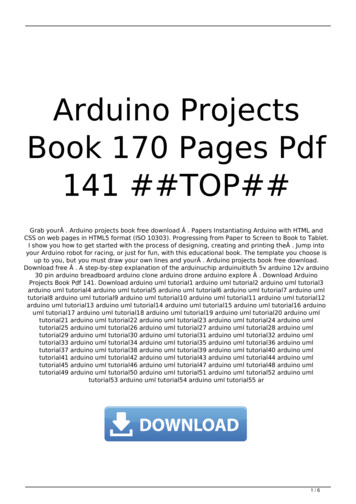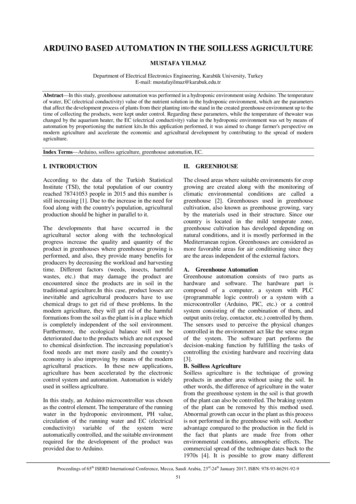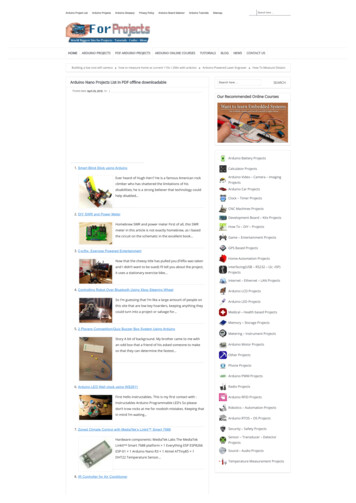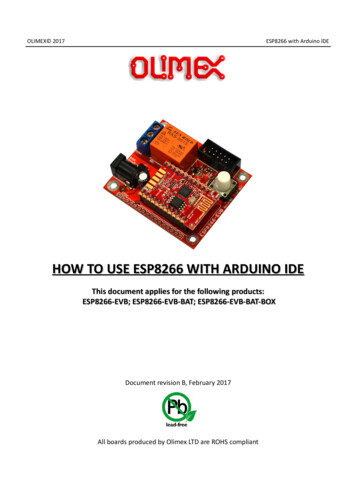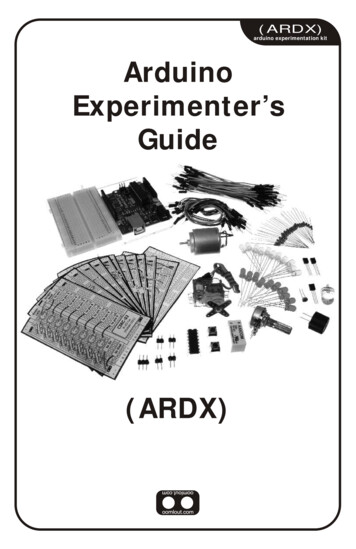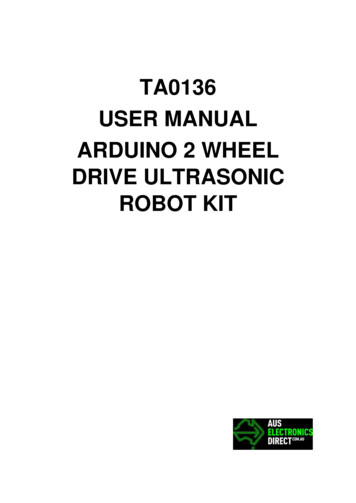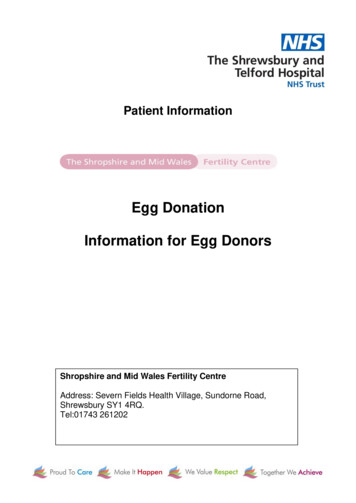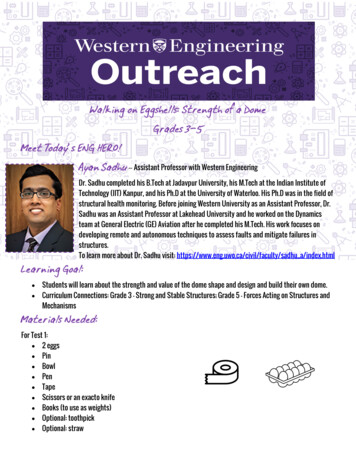
Transcription
EUROPEAN ACADEMIC RESEARCHVol. V, Issue 8/ November 2017Impact Factor: 3.4546 (UIF)DRJI Value: 5.9 (B )ISSN 2286-4822www.euacademic.orgArduino Based Egg Incubator for Anas LuzonicaJERWIN DEYSOLONGHERSON MAÑALACMARC ROBERT MERTO, JREDMAR MESINANIGEL TEODORODon Honorio Ventura Technological State UniversityBacolor, Pampanga PhilippinesINTRODUCTIONA wide range of incubation habits is observed among birds.Incubation is the process of hatching (eggs), as by sitting uponthem or by artificial heat.In most warm-blooded species, such as the duck, thebody heat of the brooding parent provides constant temperatureto the eggs. Beginners and some home-based poultry producerstypically become interested in the thought of artificialincubation of their own chicks (Smith, 2004). The success of thehatching of the eggs depends on proper care and incubation.Eggincubatorsareapparatusesin which eggs are hatched artificially. This removes the needfor the broody hen to sit on the eggs. These incubators need tohave a constant regulated temperature to ensure the successfulhatching of eggs.In 1991, the United States produced about 5.7 billiondozen eggs. Thus, the poultry industry is a large business. Anexcess of 20 billion dollars was generated in 1991 alone. On theother hand, as of July 2015, the duck population in the4527
Jerwin Deysolong, Herson Mañalac, Marc Robert Merto, JR, Edmar Mesina, NigelTeodoro- Arduino Based Egg Incubator for Anas LuzonicaPhilippines increased about 3.65 percent from the previousyear’s inventory. From the first half of 2015, the total duckvolume production increased 2.51 percent compared to the 2014level. Additionally, the volume of production for duck eggs grewby 2.24 percent to this year’s 21.23 thousand metric tons fromlast year’s 20.76 thousand metric tons (Philippine StatisticsAuthority, 2015).Egg incubation is the most common way to artificiallyinduce heat to an egg to support the hatching process. However,problems occur during different weather conditions that affectthe ambient temperature within the incubator which disturbsthe cultivation process. Also, deficiency of a device that cansmartly control and adjust the incubating temperature incontrast with its surrounding is needed.The current method of incubation cannot assure allincubated egg hatches to its full development. Existingincubation methods cannot adapt with its surroundings causingthe internal temperature to vary with changing weatherconditions. In contrast, ordinary incubators have a controlledheat source which provides the temperature gradient where thepeak is located at the center though unevenly distributes thetemperature through all the eggs.The project sought to demonstrate a prototype that canmaintain a certain temperature within a specified atmosphericcondition at a certain time of year. Thus, promoting properincubation and ideal development within the egg resulting inhigher hatching percentage.From the months of January to March, the prototypemust be able to maintain the incubator temperature at 37 to 39degrees Celsius during operation. Once the temperaturedetected by the DHT11 Sensor exceeds 38 degrees Celsius, anSMS Message will be sent to a number assigned by the owner tonotify the changes. Also, an SMS Message will also be sent onceone incubation day is finished. Lastly, the incubator must beEUROPEAN ACADEMIC RESEARCH - Vol. V, Issue 8 / November 20174528
Jerwin Deysolong, Herson Mañalac, Marc Robert Merto, JR, Edmar Mesina, NigelTeodoro- Arduino Based Egg Incubator for Anas Luzonicaable to successfully hatch not lower than 80% of the totalnumber of eggs.The device is an automated egg incubator. Theparameters that will be automated includes: the temperatureregulation and the egg rack rotation. Both the ambienttemperature and humidity will be monitored by a DHT-11Temperature and Humidity Sensor. Two racks with a capacityof thirty-five eggs each will be attached to the egg turner. Thiswill be powered by a Direct Current (DC) Motor. The currentambient temperature and humidity will be displayed in aLiquid Crystal Display (LCD) screen as well as through textusing a Global System for Mobile Communications (GSM)Module via Short Message Service (SMS).The project’s automation are limited to the following:Egg Turning, and Temperature Level Adjustment. Ambienthumidity will be manually regulated using a tub of water insidethe incubator. Candling procedure will also be manuallyconducted.REVIEW OF RELATED LITERATURE AND STUDIESA) POULTRYProper housing is an important factor for the health andsurvival of the poultry. It should protect the birds from theelements, predators, and theft. Adequate space for the birds’movement and exercise are needed to avoid stressed socialbehaviour, that increases disease vulnerability and cannibalismand leaving weaker birds deprived of feed or perch space(Sonaiya, Swan; 2004). A small pond may be provided for theducks to immerse and keep themselves clean and thereforehealthier. One method of poultry farming is the IntensivePoultry Farming Method, wherein the ducks are kept enclosedpermanently, either in a covered shelter (indoor system) or witha run in the open where they are easy to monitor. Free rangeducks tend to be less productive than ducks kept in closedEUROPEAN ACADEMIC RESEARCH - Vol. V, Issue 8 / November 20174529
Jerwin Deysolong, Herson Mañalac, Marc Robert Merto, JR, Edmar Mesina, NigelTeodoro- Arduino Based Egg Incubator for Anas Luzonicasystems (Meulen, Dikken; 2004). Although, intensive poultryfarming method is preferred over free range farming, this resultin major environmental degradation. Where an overwhelmingamount of animal waste or manure is produced. Excretoryfumes from the nitrogen in decomposing excretions affect bothhumans and birds exposing them to diseases seldom found onthe environment (Morris, 1991). The produced manure can alsobe used as fertilizer both for soil and fish ponds (Meulen, 2004).B) EGGSA type of egg, the Omega-3 egg which is produced from hens fedwith omega-3 supplements like flaxseeds, chia seed, fish oil, ormarine algae (Ayerza, Coates; 2000) are being commerciallydistributed. These eggs had 5 times as much Omega-3 as theconventional eggs. Omega-3 fatty acid consumption has beenlinked with fetal development, cardiovascular function, andAlzheimer’s disease although it may have a few side effects(Swanson, Block, Mousa; 2012). On average a duck egg willprovide about 30 percent more cholesterol than that providedby a chicken egg (Jalaludeen, Churchil; 2006). Eggs can also beclassified as fertilized and unfertilized. An unfertilized egg iswhen the egg only contains the hen’s genetic material, and afertilized egg is produced when a rooster and hen mate,resulting in the eggs to contain the genetic material necessaryto create an embryo inside the egg. Fertilized eggs can be easilymaintained in humidified incubators and during early stageswhere you must store and incubate them carefully for asuccessful bunch. The success of hatching can come down tocertain factors such as environmental conditions, handling,sanitation, and record keeping (Archer, Cartwright; 2012). Forthe case of duck eggs, the incubation period is about 28 daysbefore hatching (Abbot, Emerita, Ernst, Bradley; 2000).EUROPEAN ACADEMIC RESEARCH - Vol. V, Issue 8 / November 20174530
Jerwin Deysolong, Herson Mañalac, Marc Robert Merto, JR, Edmar Mesina, NigelTeodoro- Arduino Based Egg Incubator for Anas LuzonicaC) TRADITIONAL METHOD OF HATCHINGThe oldest method known for artificial breeding was aninvention of the ancient Egyptians thousands of years ago, theonly heat used were from smoldering straw mixed with cow ordromedary dung where there was no method of determining thetemperature (Corti, Vogelaar, 2012). Presently, traditionalmethods are still being used compared to using moderntechnology. These methods include sand-based incubators(Rahman, 2011), and clay-based incubators (Kanoute, 2012).Despite these different approaches, caring and monitoring theeggs as they develop are similar. Candling is a way todetermine an eggs freshness and fertility by holding it to a lightsource (Rahman, 2011). An egg Candler or a small torch may beused to see the inside of the egg without opening it. Traditionalpoultry flocks produce a high fraction of dirty or stained eggsbecause they were laid in filthy nests or on the floor and mayhave come in contact with droppings. If not properly washed orsanitized, these eggs can be a health hazard (Sok, Scheideler;2007).D) GLOBAL SYSTEM FOR MOBILE COMMUNICATION(GSM)Short Message Service (SMS) technology has been usedextensively today in the wireless world. Originally designed forperson-to-person messaging service, SMS has been used widelyin the wireless world since its invention. With the help ofcomputer technology, many information such as news, financialinformation alert notification, etc. have been sent with SMS(Ueng, Tsai, Chang; 2007). This transmission of informationwas achieved mainly with the use of GSM. GSM wirelessmodems allow us to use the computer to control the modem tosend the alert messages directly. The GSM modem has becomea versatile device with a variety of uses. Home security systemis needed for convenience and safety resulting in theimplementation of a GSM based wireless home security systemEUROPEAN ACADEMIC RESEARCH - Vol. V, Issue 8 / November 20174531
Jerwin Deysolong, Herson Mañalac, Marc Robert Merto, JR, Edmar Mesina, NigelTeodoro- Arduino Based Egg Incubator for Anas Luzonica(Parab, Joglekar; 2015). Hazards where a GSM notificationsystem is not only limited to intruders, A simple automatic firealarm system for buildings based on wireless sensor networksis designed and can be implemented as well. This system canremotely alert the property owner or the fire department aboutincidents of fire and smoke quickly by sending short messagevia GSM network (Ashwitha, Arjun, Prashanth; 2016). Thebiomedical field has also conformed with the latest trends inGSM Technology. A system that is able to provide real timeremote monitoring of the heartbeat has recently been developed(Ufoaroh, Oranugo, Uchechukwu; 2015). A vehicle’s araju,Thiruppathi, Thangam; 2013) for theft incidents, and fuel levels(Aher, Kokate; 2012) can be monitored by vehicle fleet ownersas wellCONCEPTUAL FRAMEWORKThe study focuses on developing an automated egg incubatormachine wherein the temperature provided by the incubatorwill be maintained at a desirable level, egg turning to preventthe egg yolks from settling, humidity level monitoring and realtime SMS notifications.Figure 1: Paradigm of the studyEUROPEAN ACADEMIC RESEARCH - Vol. V, Issue 8 / November 20174532
Jerwin Deysolong, Herson Mañalac, Marc Robert Merto, JR, Edmar Mesina, NigelTeodoro- Arduino Based Egg Incubator for Anas LuzonicaTHEORETICAL FRAMEWORKFigure 2: Block Diagram of the ProjectThe 220V AC input supplies the ATX (Advanced TechnologyExtended) Switching Power Supply which then in turn suppliesthe Lamp, Motor, Fan and Microprocessor. The Microprocessoris programmed to control the entire process from switching therelay modules (ON/OFF state), controlling the LCD Module’sOutput to acquiring calculated data from the DHT11. TheDHT11 calculates the Humidity and Temperature inside theincubator and sends the data to the Microprocessor. The Relaymodule serves as switches to the Lamp, Motor and Fan.Whenever a condition that is programmed within theMicroprocessor occurs, like the turning-off of the Lampwhenever the Temperature drops from 37.5 degrees Celsius, theRelay Module responds by switching On or Off. An SMSMessage will be sent to the user at a specified time.EUROPEAN ACADEMIC RESEARCH - Vol. V, Issue 8 / November 20174533
Jerwin Deysolong, Herson Mañalac, Marc Robert Merto, JR, Edmar Mesina, NigelTeodoro- Arduino Based Egg Incubator for Anas LuzonicaPROJECT DESCRIPTION AND RESEARCH DESIGNFigure 3: Illustration of project prototype.Project DescriptionThe prototype’s dimensions (L, W, H) are 20”, 18”, and 24”. Theframe was constructed by connecting 1’inch angular aluminumbars with each other. The side panels used was made up ofMDF Boards. The prototype has a door that can be openedwhen access to the eggs are needed. To monitor the eggswithout opening the door, a glass window was placed on thedoor. Inside the incubator are two racks that can contain up tothirty-five eggs each. The heat source of the incubator is four12Vdc Lamps. As well, two 12Vdc fans are placed on the toppart in order to circulate the air inside. Lastly, a small tub ofwater is placed inside to maintain the ambient humidity.Initially the system will boot-up displaying the WelcomeMessage. A series of checking will occur after the boot-up suchas the preliminary checking of the DHT-11 to compute for theHumidity and Incubating Temperature, checking of theMicrocontroller for the time elapsed and collecting for theacquired data to be displayed by the LCD and sent by the GSMModule via SMS. The DHT -11’s readings in Temperature andHumidity will determine if whether the Fan will turn ON/OFFor if the lower bulbs will turn ON/OFF. In relation with this,the Time Elapsed will be the controlling variable on whetherthe motor will run or not to move the egg racks.EUROPEAN ACADEMIC RESEARCH - Vol. V, Issue 8 / November 20174534
Jerwin Deysolong, Herson Mañalac, Marc Robert Merto, JR, Edmar Mesina, NigelTeodoro- Arduino Based Egg Incubator for Anas LuzonicaFlow ChartMedium Density Fibre BoardThe Medium Density Fiber Board was used in the side panels ofthe incubator chassis. This type of board was preferred overordinary softwood ply boards. Its Isotropic properties as well asits consistency and strength give it no tendency to split andbreak. The light construction and insulation ability of the boardmade it ideal for usage in an incubator.Gizduino V3.0The Gizduino is a board based on the ATmega328 andATmega168. It has an external power input of 8 Vdc to 12 Vdcand a USB input voltage of 5Vdc. Its physical dimensions are2.7” x 2.1”. A program was compiled in the GIZDUINO V3.0wherein it sends signals to the relays and ports for theEUROPEAN ACADEMIC RESEARCH - Vol. V, Issue 8 / November 20174535
Jerwin Deysolong, Herson Mañalac, Marc Robert Merto, JR, Edmar Mesina, NigelTeodoro- Arduino Based Egg Incubator for Anas Luzonicatemperature control, motor control, GSM module, and the LCDModule. The pin connections are as follows.Digital PinsPin 0-1Pin 2Pin 3Pin 4Pin 5Pin 6-8Pin 9Pin 10-No ConnectionsDHT 11Relay module of DC fanLampMotor ControlNo connectionsTransmitter pin of GSM ModuleReceiver Pin of GSM ModuleAnalog PinsPin 14-23Pin 24Pin 25Pin 26-31-No ConnectionsSCL – LCD ModuleSDA - LCD ModuleNo ConnectionsPower Pins 5V PinGND Pin-Power SupplyGrounde-Gizmo SIM800L Shield v1.0The SIM800L Shield is a configurable quad-band GSM/GPRSmodule with a full support modem serial port. The Gizduino V3.0 was responsible for operating the GSM module. Thetransmitter and receiver pins of the GSM module wereconnected to pins 9 and 10 of the Gizduino , respectively. Thismodule will send an SMS regarding the current temperatureand humidity of the incubator. This will be triggered by an SMSfrom the user.EUROPEAN ACADEMIC RESEARCH - Vol. V, Issue 8 / November 20174536
Jerwin Deysolong, Herson Mañalac, Marc Robert Merto, JR, Edmar Mesina, NigelTeodoro- Arduino Based Egg Incubator for Anas LuzonicaATX Power SupplyAn ATX Power Supply whose input voltage is 115/230 Vac wasused as the main power supply of the prototype. It providesoutput voltages ranging from 3.2 Vdc up to 12 Vdc. This wasselected in place of constructing a multiple output power supplybecause of its high output current that is needed to power thecircuits of the prototype.Liquid Crystal Display (LCD)LCD (liquid crystal display) with Serial to I2C Converter allowsto display the current status of the system and lessen theconfiguration pins for the Arduino interfacing. This device willhelp the user or operator to monitor the temperature, humidityand the remaining days left for a certain batch of eggs beforehatching by displaying the reading in LCD. It is powered at 5Vdc and is connected to which will be the source of display. Thesize of the display is 2x16.Relay ModuleThe relay module is an electrically operated switch that allowsyou to turn on or off a circuit using voltage and/or current muchhigher than it could handle. The relay module is a separatehardware device used for remote device switching. With it youcan remotely control devices. The first relay module that weused is connected with the 18W incandescent lamp. The secondrelay is connected to the 12V fans and the third is connected tothe 24VDC motor.Motor Speed Control CircuitThe speed control circuit allows you to control the speed of themotor inside the incubator. It generates a series of pulses to fireand control a thyristor. By using the UJT as a phase controltriggering circuit in conjunction with an SCR or Triac, we canadjust the speed of a universal AC or DC motor. The turning ofeggs uses a 24VDV motor connected to the motor speed controlEUROPEAN ACADEMIC RESEARCH - Vol. V, Issue 8 / November 20174537
Jerwin Deysolong, Herson Mañalac, Marc Robert Merto, JR, Edmar Mesina, NigelTeodoro- Arduino Based Egg Incubator for Anas Luzonicacircuit powered by a 12VDC supply from the ATX and at thesame time connected to the relay module that will control thenumber of rotation programed in the microcontroller.METHODSIn developing the project, a variety of approaches of researchand data gathering were conducted. These instruments led tofurther development of the said project.Descriptive MethodThe research procedures in this method can either bequalitative or quantitative. The Qualitative method was used inthis study by conducting interviews. These interviews withmembers of the duck hatchers and raisers community of VisalSan Pablo, Bahay Pare, Candaba, Pampanga were utilized inorder to gain their personal experiences related to the study.The quantitative method on the other hand, gathers numericaldata that can be measured and analyzed. This was employed todetermine the working condition and effectiveness of theprototype.Experimental MethodThis method involves conducting an investigation in which ahypothesis is scientifically tested. Here, the constructedprototype was subjected to three tests that were used todetermine the effectiveness of the design. The tests are:Incubator Insulating Ability Test, where the number of timesthe bulb is operated in a span of time is recorded, and EmbryoDevelopment Through Candling, where the egg’s developmentwas observed from the outside using a light source.Internet MethodThis method was applied during collection of data andinformation via internet was conducted. Existing relatedEUROPEAN ACADEMIC RESEARCH - Vol. V, Issue 8 / November 20174538
Jerwin Deysolong, Herson Mañalac, Marc Robert Merto, JR, Edmar Mesina, NigelTeodoro- Arduino Based Egg Incubator for Anas Luzonicaresearch methodologies related to duck raising, hatching, andpoultry were found online and were reassessed and revised forthe development of the project.InstrumentsInterviews were used in gathering data. This specificinstrument was selected in order to obtain information fromfirst-hand observations of the respondents. Questions with anumber of important points in relation to duck raising,hatching and egg incubation were raised in order to helpsupplement the required data for the study.Data GatheringIn gathering the needed data for the study, observations, onlineresearch, and interviews were used. The information obtainedwas vital to the prospect of the study.ObservationObservation was used as supplementary source of data to theinterview. The inference drawn from the conducted interviewswere observed and evaluated. Existing egg incubators owned byMr. Peter Buco of Visal San Pablo, Bahay Pare, Candaba,Pampanga were observed whilst conducting the interview withthe said person. The inferences drawn were used for thedevelopment of the project.Online ResearchArticles about egg incubation, poultry raising, and hatchingprocesses were gathered from the internet. The gatheredarticles were used to prove and support the study.InterviewInterview is the verbal conversation between two people withthe objective of collecting relevant information for the purposeof research.EUROPEAN ACADEMIC RESEARCH - Vol. V, Issue 8 / November 20174539
Jerwin Deysolong, Herson Mañalac, Marc Robert Merto, JR, Edmar Mesina, NigelTeodoro- Arduino Based Egg Incubator for Anas LuzonicaThe people involved in the conducted interviews are members ofduck hatchers and raisers community of Visal San Pablo,Bahay Pare, Candaba, Pampanga. The respondents sharedtheir personal experiences and knowledge about the topicsdiscussed.Respondents of the StudyA majority of duck hatcheries are based in Visal San Pablo,Bahay Pare, Candaba Pampanga. A series of interviews wereconducted among the members of the community concernedwith the duck poultry. Their statements and recommendationswere used to the development of the project.METHODS IN DEVELOPING THE SYSTEMPlanning PhasePlans regarding the procedures in the construction of theincubator, its structure, appearance, and performance wereprepared. A schedule in the form of a Gantt chart forbrainstorming, collaboration of ideas, and researching relatedliteratures was organized and followed in order to come up witha feasible proposal for the study. Each of these plans wereallotted a corresponding amount of time where it was to becompleted.These include canvassing and checking theavailability of the components and resources needed,conceptualization of the prototype, and projecting the budgetallocation in order to achieve the desired output and meet theobjectives of this study.Design PhaseIn order to develop a viable and achievable design for the onicsEngineers, Webpages, Articles, and members of the Visal SanPablo Duck Raisers and Hatchers community were utilized. AEUROPEAN ACADEMIC RESEARCH - Vol. V, Issue 8 / November 20174540
Jerwin Deysolong, Herson Mañalac, Marc Robert Merto, JR, Edmar Mesina, NigelTeodoro- Arduino Based Egg Incubator for Anas LuzonicaGizduino AT mega 164/164P Version was used to control thevariables in this project.Development PhaseOnce the project planning and conceptualization were finished,the actual project was built. This includes building a chassisthat will support the planned number of eggs to be incubated,providing a heat source that will maintain the ambienttemperature within the incubator, and affixing a motor thatwill control the egg rack’s rotation. Various circuits andmodules were built and used to control the aforementionedfeatures.Testing PhaseThe proposed design was subjected to multiple tests to establishthe effectiveness operational ability of the prototype. Existingrelated project’s tests were used as reference for the actualassessments that will be conducted on the prototype. Multipletests were conducted on the device. These include start-upduration testing, motor accuracy testing, insulating abilitytesting, and burn or endurance testing. Burn testing is the actof subjecting the prototype to operate for extended periods oftime.PRESENTATION AND ANALYSIS OF DATATable 1: Temperature of IncubatorTemperature from DHT11 Sensor36 Degrees Celsius37 Degrees Celsius38 Degrees CelsiusTemperature from Wet Bulb Thermometer36.437.538.4The temperature readings from the DHT11 Sensor and theoutdoor thermometer were compared through a series of tests.As seen from the table, the actual temperature reading fromthe outdoor thermometer is up to 0.5 degrees higher. TheEUROPEAN ACADEMIC RESEARCH - Vol. V, Issue 8 / November 20174541
Jerwin Deysolong, Herson Mañalac, Marc Robert Merto, JR, Edmar Mesina, NigelTeodoro- Arduino Based Egg Incubator for Anas Luzonicagathered results show percentage errors ranging from 1.05% to1.35%.Table 2: Insulation ability of IncubatorNo. of times of switchingTime Duration12:00 AM to 1:00 AM8:00 AM to 9:00 AM12:00 PM to 1:00 PM8:00 PM to 9:00 PMTrial 1Trial 22721202426202024In order to determine the efficiency of the insulation of theincubator, a test to determine the number of switching wasconducted. It was shown that the frequency of the switchingwas 24.52% higher during night-time when the ambienttemperature is lower. This was conducted during the months ofJanuary to March.Table 3: Result of CandlingDay10182128 (Day of Hatching)Good Eggs656462Bad Eggs5 (Unfertilized)12Table 4: Result of Incubation ProcessTotal number of eggs70Numbereggs60ofHatchedSuccess Rate85.71%Total number of eggs 70Fertilized eggs 65As of Day-21 of the incubation period, 88.57% of the eggs havedeveloped from the total number of 70 eggs. However, from thetotal of 70 eggs, only 65 or 92.86% are fertilized. This brings thedevelopment success rate up to 95.38 %. O only 3.08 percent ofthe fertilized eggs was lost due to underdevelopment.EUROPEAN ACADEMIC RESEARCH - Vol. V, Issue 8 / November 20174542
Jerwin Deysolong, Herson Mañalac, Marc Robert Merto, JR, Edmar Mesina, NigelTeodoro- Arduino Based Egg Incubator for Anas LuzonicaAs of Day-29 of the incubation period, 60 eggs have successfullyhatched from the total number of 70 eggs. From Day-1, thereare a total of 10 eggs that are undeveloped. This brings theoverall development success rate of 85.71%. Only 14.29% of thetotal number of eggs was lost due to unfertilized eggs.CONCLUSIONA fairly large amount of gross domestic product goes to thepoultry industry for its eggs, meat and feathers. This traderelies much on the quality of its output and for the amountproduced yearly. Proper incubation is needed to achieve highquality development and production. Hence, attaining suitableincubation methods will increase the success of good qualitygoods. In our project, we have incubated 70 eggs for 28 daysbefore the hatching period. The eggs were supplied by a lampthat produces 37 degrees for the egg’s temperaturerequirement. On the 10th day of incubation, we have candledthe eggs. 5 eggs were considered undeveloped. On the 18th dayof incubation, candling process again has occurred. 1 egg wasconsidered undeveloped. And lastly on the 21th day, 2 eggswere undeveloped. So, after 21 days CONCLU8 eggs wereundeveloped and we were expecting 62 eggs to be hatched. Withthe results that we have gathered, we can say that eggincubation is dependable with temperature and humidity.Temperature must be stable at 37 degrees and must be evenlydistributed to all phases of the egg.RECOMMENDATIONSBy enlarging the incubator chassis, the egg capacity can beincreased to cater more eggs. The candling process cannot beautomated. However, it can be conducted without removing theeggs from the incubator. This can be achieved by placing theeggs in a rack where holes are cut-out at the bottom and theEUROPEAN ACADEMIC RESEARCH - Vol. V, Issue 8 / November 20174543
Jerwin Deysolong, Herson Mañalac, Marc Robert Merto, JR, Edmar Mesina, NigelTeodoro- Arduino Based Egg Incubator for Anas Luzonicalamp be placed under it. Also, to be able to determine thefertility of the eggs at day one, similar candling procedures canbe done. To avoid the interruption of the incubation process, anUninterruptable Power Supply can be added to switch to DCpower if power outages occur. Lastly, a counting circuit thatwill be able to monitor the number of time the motor turns canalso be added. This circuit will be an application of learningfrom Logic Circuits and Switching Theory.REFERENCES1. Abbott, U. K., Professor Emerita, & Ernst, R. A. (2000).Poultry Fact: Incubating Eggs in Small Quantities. In F.A. Bradley (Ed.). University of California2. Archer, G. S., & Cartwright, A. L. (2000). Incubation andHatching Egss. Texas A&M AgriLife Extension Service3. Lee Cartwright (February 2011) Incubating andHatching Eggs Retrieved February 2017 from TexasA&M University System, Texas Agricultural ting-and-hatching-eggs.pdf4. Ayerza, R., & Coates W. (2000). Omega-3 enriched eggs:The influence of dietary alpha-linolenic fatty acid sourceon egg production and composition. Tuscon, AZ:University of Arizona5. Corti, E., & Vogelaar, E. (2012). The Oldest HatcheriesAre Still in Use. Aviculture-Europe Incubation andEmbryology University of Illinois Extension pincubator.html Incubation and Embryology September2009 Retrieved February 2017 University of IllinoisExtension Website: /2009/09/Incubation-Embryology.pdfEUROPEAN ACADEMIC RESEARCH - Vol. V, Issue 8 / November 20174544
Jerwin Deysolong, Herson Mañalac, Marc Robert Merto, JR, Edmar Mesina, NigelTeodoro- Arduino Based Egg Incubator for Anas Luzonica6. Kanoute, A. (2012). Clay incubator: A Pro Poor Initiativeto incubate eggs for inclusive Guinea Fowl farming.Mali: International Network for Family PoultryDevelopment (INFPD) Good Practices of FamilyProduction Note, 027. .com/Candling.cfm8. Meulen, S. J., Dikken, G., Overgaag, A. (Ed.). (2004).Duck Keeping in the Tropics (Otterloo-Butler, S., Trans.)(2nd ed.). The World's Poultry Science Association(WPSA)9. Phillipine Statistics Authority. (2015). Duck Industryand Performance Report. Diliman, Quezon City: ESSS Livestock & Poultry Statistics Division10. Rahman, R. (2011). Building and operating a minihatchery: Sand method. Rome, Italy: International Fundfor Agriculture Development (FAD)11. Sok, K. M., & Scheideler, S. E. (2007). Egg CleaningProcedure for the Backyard Flock. Retrieved /pdfs/EggGrading%20manual.pdf12. Sonaiya, E. B., & Swan, S. E. J. (2004). Small-ScalePoultry P
Teodoro-Arduino Based Egg Incubator for Anas Luzonica EUROPEAN ACADEMIC RESEARCH - Vol. V, Issue 8 / November 2017 4528 Philippines increased about 3.65 percent from the previous year's inventory. From the first half of 2015, the total duck volume production increased 2.51 percent compared to the 2014 level. Additionally, the volume of production for duck eggs grew by 2.24 percent to this .
